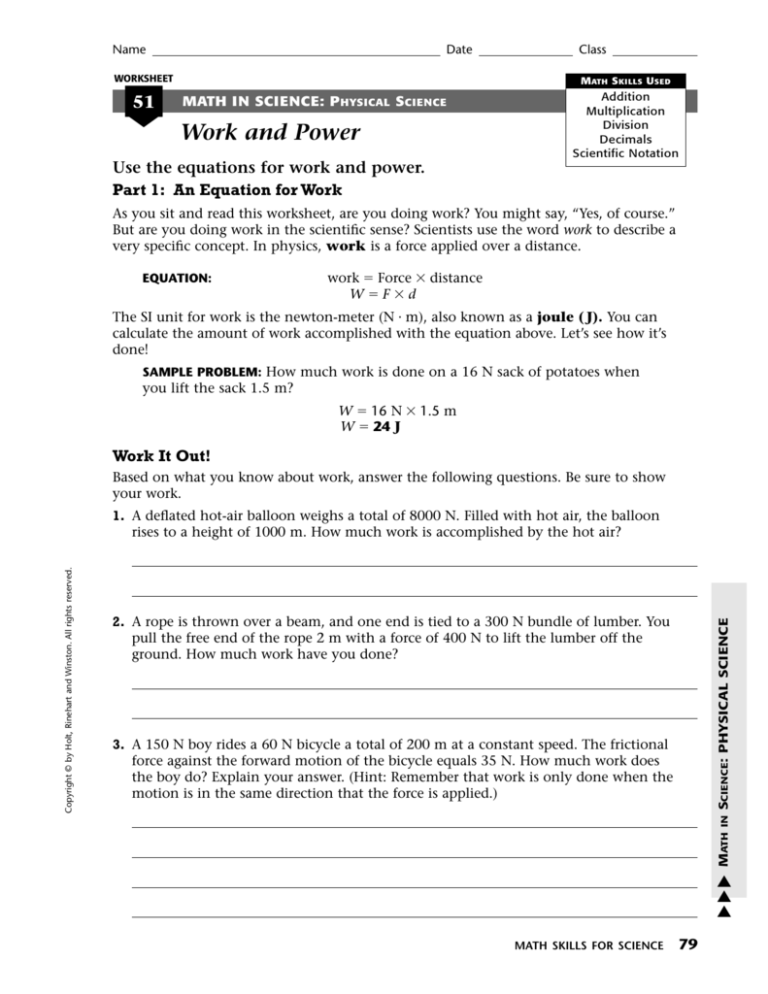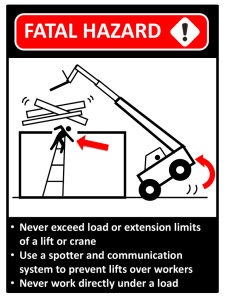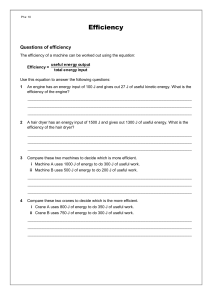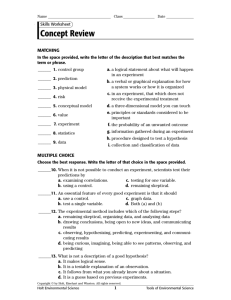
Name
Date
WORKSHEET
51
Class
MATH S KILLS U SED
MATH IN SCIENCE: P HYSICAL SCIENCE
Work and Power
Addition
Multiplication
Division
Decimals
Scientific Notation
Use the equations for work and power.
Part 1: An Equation for Work
As you sit and read this worksheet, are you doing work? You might say, “Yes, of course.”
But are you doing work in the scientific sense? Scientists use the word work to describe a
very specific concept. In physics, work is a force applied over a distance.
EQUATION:
work Force distance
WFd
The SI unit for work is the newton-meter (N m), also known as a joule ( J). You can
calculate the amount of work accomplished with the equation above. Let’s see how it’s
done!
SAMPLE PROBLEM: How much work is done on a 16 N sack of potatoes when
you lift the sack 1.5 m?
W 16 N 1.5 m
W 24 J
Work It Out!
Based on what you know about work, answer the following questions. Be sure to show
your work.
SCIENCE: PHYSICAL SCIENCE
2. A rope is thrown over a beam, and one end is tied to a 300 N bundle of lumber. You
pull the free end of the rope 2 m with a force of 400 N to lift the lumber off the
ground. How much work have you done?
MATH
IN
3. A 150 N boy rides a 60 N bicycle a total of 200 m at a constant speed. The frictional
force against the forward motion of the bicycle equals 35 N. How much work does
the boy do? Explain your answer. (Hint: Remember that work is only done when the
motion is in the same direction that the force is applied.)
▼
▼
▼
Copyright © by Holt, Rinehart and Winston. All rights reserved.
1. A deflated hot-air balloon weighs a total of 8000 N. Filled with hot air, the balloon
rises to a height of 1000 m. How much work is accomplished by the hot air?
MATH SKILLS FOR SCIENCE
79
Name
Date
Class
Work and Power, continued
Part 2: Work and Power
Work is closely related to the concept of power. Power is a measure of how much work
is done in a certain time. The faster work is done, the more power is produced.
work
power time
EQUATION:
W
P
t
The unit for power is the watt (W). One watt (W) is equal to 1 J of work done for 1 second. Use the data given in the diagram below to determine how much work and power
are involved in each step. Remember to show your work.
Height of
ladder = 2 m
Height of
stairs = 3 m
Step 1: A 50 N girl climbs the flight of
stairs in 3 seconds.
Work Power Step 2: The girl lifts a painting to a
Step 3: The girl climbs the ladder with
height of 0.5 m in 0.75 seconds.
the painting in 5 seconds.
Work
Work
Power
Power
Challenge Yourself!
4. A crane lifts a load of steel that weighs 9.3 105 N a distance of 100 m. It takes 5
minutes to complete the task.
a. How much work is done by the crane?
b. How much power does the crane produce?
80
HOLT SCIENCE AND TECHNOLOGY
Copyright © by Holt, Rinehart and Winston. All rights reserved.
Force necessary to
lift painting = 60 N
Name
Date
WORKSHEET
51
Class
MATH S KILLS U SED
MATH IN SCIENCE: P HYSICAL SCIENCE
Work and Power
Addition
Multiplication
Division
Decimals
Scientific Notation
Use the equations for work and power.
Part 1: An Equation for Work
As you sit and read this worksheet, are you doing work? You might say, “Yes, of course.”
But are you doing work in the scientific sense? Scientists use the word work to describe a
very specific concept. In physics, work is a force applied over a distance.
EQUATION:
work Force distance
WFd
The SI unit for work is the newton-meter (N m), also known as a joule ( J). You can
calculate the amount of work accomplished with the equation above. Let’s see how it’s
done!
SAMPLE PROBLEM: How much work is done on a 16 N sack of potatoes when
you lift the sack 1.5 m?
W 16 N 1.5 m
W 24 J
Work It Out!
Based on what you know about work, answer the following questions. Be sure to show
your work.
1. A deflated hot-air balloon weighs a total of 8000 N. Filled with hot air, the balloon
rises to a height of 1000 m. How much work is accomplished by the hot air?
3. A 150 N boy rides a 60 N bicycle a total of 200 m at a constant speed. The frictional
force against the forward motion of the bicycle equals 35 N. How much work does
the boy do? Explain your answer. (Hint: Remember that work is only done when the
motion is in the same direction that the force is applied.)
35 N 200 m 7000 J; The weights of the boy and the bicycle are not used to calculate the work
done because the direction of their forces (downward) is different than the direction of the motion
(forward).
MATH
400 N 2 m 800 J
IN
SCIENCE: PHYSICAL SCIENCE
2. A rope is thrown over a beam, and one end is tied to a 300 N bundle of lumber. You
pull the free end of the rope 2 m with a force of 400 N to lift the lumber off the
ground. How much work have you done?
▼
▼
▼
Copyright © by Holt, Rinehart and Winston. All rights reserved.
8000 N 1000 m 8,000,000 J
MATH SKILLS FOR SCIENCE
79
Name
Date
Class
Work and Power, continued
Part 2: Work and Power
Work is closely related to the concept of power. Power is a measure of how much work
is done in a certain time. The faster work is done, the more power is produced.
work
power time
EQUATION:
W
P
t
The unit for power is the watt (W). One watt (W) is equal to 1 J of work done for 1 second. Use the data given in the diagram below to determine how much work and power
are involved in each step. Remember to show your work.
Height of
ladder = 2 m
Height of
stairs = 3 m
Step 1: A 50 N girl climbs the flight of
stairs in 3 seconds.
Work 50 N 3 m 150 J
Power 150 J 3 s 50 W
Step 2: The girl lifts a painting to a
Step 3: The girl climbs the ladder with
height of 0.5 m in 0.75 seconds.
the painting in 5 seconds.
Work 60 N 0.5 m 30 J
Work 50 N 60 N 110 N
110 N 2 m 220 J
Power 30 J 0.75 seconds 40 W
Power 220 J 5 seconds 44 W
Challenge Yourself!
4. A crane lifts a load of steel that weighs 9.3 105 N a distance of 100 m. It takes 5
minutes to complete the task.
a. How much work is done by the crane?
(9.3 105 N) 100 m 9.3 107 J, or 93,000,000 J
b. How much power does the crane produce?
(9.3 107 J) 300 seconds 3.1 105 W, or 310,000 W
80
HOLT SCIENCE AND TECHNOLOGY
Copyright © by Holt, Rinehart and Winston. All rights reserved.
Force necessary to
lift painting = 60 N









